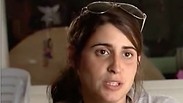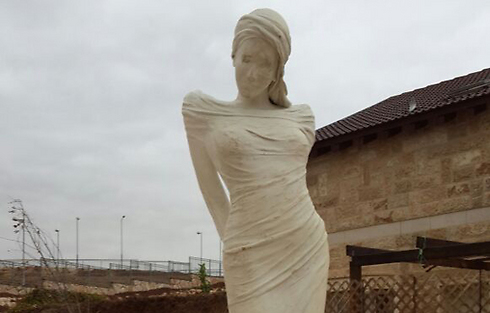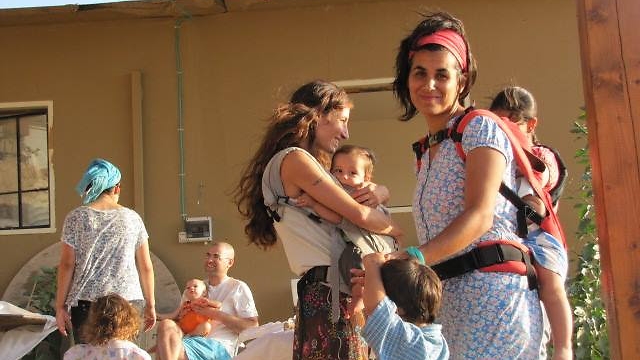
Can religious and secular Jews really live together?
There is no doubt that integrated community is a complex reality that requires much consideration and patience, but for many it is a simple and desirable life
While the days of elections are over, it seems that the polarization within Israeli society will continue for a very long time. But for dozens of communities and thousands of families across the country, this debate is detached from reality – they choose a reality of sharing a life together, and see it as the best option for their own good and for the education of their children.
We are used to hearing about cases of struggles over religious crowds "taking over" secular neighborhoods. But after speaking with people who live in integrated neighborhoods and communities, it turns out that sometimes this is a rather conscious and idealistic choice. People see the joint life and shared experience as the essence of the Jewish Israeli experience, and strive to "purposely" belong to a diverse and accepting community, rather than a homogenous one.
The essential experience
Recently a story was published about a statue called "The Smart Woman" – a biblical figure who resided in the area of Tekoa – that was placed in Gush Etzion. Tekoa is a mixed community of religious and secular residents, and it is considered somewhat liberal as many artists reside in it as well.
The communal town's rabbi up until two years ago was Rabbi Menachem Froman, one of the most colorful characters in the religious Zionist movement, who advocated for co-existence between religious and secular crowds as well as Jewish and Arab communities.
Placing the sculpture by Ariela Beit On caused a riot after the religious residents of the town claimed it was provocative, both because of its prominent feminine contours and because it supposedly violates the second commandment that states "Thou shalt not make unto thee any graven image."
Beit On, a resident of Tekoa, created the sculpture as part of a series of statues set to be placed around the town, and even though the exhibition was given the approval of Rabbi Ariel Holland, a Tekoa resident, someone chose to smash part of the sculpture.
The story was portrayed as a struggle between the religious and secular residents of Tekoa, and presented the challenges of living together as uneasy and even impossible. But apparently the residents themselves see things differently.
"This is not a struggle of religious vs. secular; it is a legitimate debate within our joint community. Among those who oppose the statue are several seculars, and at the same time some of the supporters are religious," says Adam Tzachi, a resident of Tekoa.
According to Tzachi, the debate within the community on the matter is a fruitful one, and the man who decided to harm the statue is known to generally act abnormally.
"It is acceptable and legitimate, just like in any community, to have differences of opinion on various issues. Unfortunately, the media enjoys presenting the polarity and showing things as if they were a war between religious and secular crowds for rating purposes," says Tzachi.
He points out that the act of one madman was presented as part of the debate among the town's residents, which according to him is far from true.
Seeking understanding and compassion
"Someone from Kfar Saba contacted us a few weeks ago and expressed her desire to establish a mixed community," says Ayelet Meridor of "Mirkam" – an organization that incorporates some 30 assorted communities and works towards strengthening and unifying them though various ways.
"I suggested, first of all, that she finds out if there are in fact people who are interested in that. Within the hour she called back thrilled to say that one simple message that was sent through several WhatsApp groups led to 97 families that expressed an interest and will to be part of such a community."
According to her, integrated communities are being established in several locations around the country, and not only in specific towns. "This is not necessarily a matter of geography, but a matter of coming together and wanting to belong," claims Meridor.
"People come to the mixed community because they don't want to be part of the polarization that exists within the Israeli society, and they seek the understanding and the compassion," says radio personality Naomi Ravia, who lives and belongs to the "Keshet" community in Mazkeret Batya. In Ravia's case it is a way of life – she and her husband, Anthony, are a mixed couple: He is religious and she is secular, and they sent their children to the community's school that also integrates religious and secular students.
"Within the mixed community there is always freedom to discuss and debate anything, and there are no irrefutable axioms," says Ravia, who clarifies that in her view the country is too divided. "Our premise is that all the options are on the table. In my opinion, that is essential in raising and educating children in the Jewish Israeli world."
The desire to belong
"Mirkam" believes that every community revolves around a sense of belonging. "The desire to want to be a part of something is a human need. In modern times, people are very present on social media, which is a solution that is not necessarily real to their need to feel like they belong somewhere," claims Meridor.
The synagogue is a significant anchor in the activity of many religious communities, and its absence from the secular world creates a sense of desire among many in the secular crowds.
"The religious people who are part of a mixed community usually come from very closed and homogenous places," explains Meridor. "But many times they feel that being part of their original communities requires a behavior that is overly strict and is not suitable for them."
Within the mixed communities, the interest in Judaism usually stays within the lines of values and a moral belonging rather than actual ritualistic and religious activities, though in many of the communities everyone celebrates the Jewish holidays together and holds joint prayers.
"We believe that the Jewish-Israeli-Zionist story is one that belongs to everyone, not just the religious people. This is what the new Israeli Judaism is," says Meridor.
In her opinion, the reality of life in Israel, in which there is a separation into different sectors, has not proven itself fruitful and she believes it is time to disconnect from that and be concerned not with what differentiates, but with what connects and links.
The people of "Mirkam" emphasize that the goal is not create a one-time encounter between secular and religious people, as other organization do. "We say that the story is one of an entire life – not just one encounter. Meeting up is fun, but it is not what the Israeli society needs. We need to create one diverse society, but one that is also united, and remember what we share rather than what we don't," clarifies Meridor.
Difficulties and challenges are a must
"There are differences, and there are questions regarding what the synagogue would look like, and other dilemmas as well, but the friction and open debate generates thought, and that to me is necessary and positive in the education of children," says media personality Dr. Yoaz Hendel, who lives in the integrated community of Nes Harim. He points out that religious children who grow up in such a reality choose to observe and perform their mitzvahs on their own and not just automatically.
According to him, living in a mixed community creates an atmosphere of moderation and true bridging between the religious and the secular worlds, precisely because it confronts the differences head on and generates a discussion.
Ayelet Meridor believes that despite the disagreements, most of the integrated discourse is one of rights and not one of concessions. According to her, both sides make concessions.
"Compromising is not a bad thing, it makes you stronger. The religious residents are also in a complex place, and a lot of patience is required from both sides. We should not discuss the costs, but the benefits that arise from the mixed environment."
"Our community is very fun; we take care of each other all the time. If a woman gives birth, she gets warm meals for two weeks, and if someone is sick everyone rushes to help", concludes Ravia.












